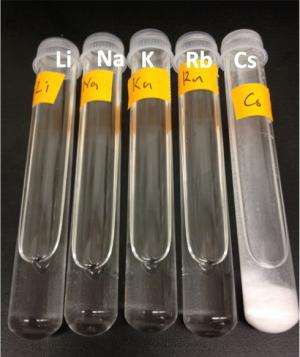Plant-based molecule may be key to cleanup of Fukushima nuclear reactor disaster

A Virginia Tech professor is part of a team of scientists from Japan and the United States that may have discovered a way to remove radioactive cesium from the millions of gallons of contaminated water being held at Japan's Fukushima Daiichi Nuclear Power Plant following the 2011 disaster.
"Radioactive cesium is the major radioactive component from the reactor," said Barry Goodell, professor of sustainable biomaterials in Virginia Tech's College of Natural Resources and Environment. "Researchers in Japan have been seeking better ways to selectively separate out and collect the cesium from the wastewater and from seawater where the radioactive material has leaked, but it has been a difficult challenge."
The team's discovery stemmed from their work with lignin, a component of plant cell walls that is a hugely abundant byproduct of pulp and paper production.
Yuichiro Otsuka, a researcher at the Forestry and Forest Products Research Institute in Tsukuba, Japan, and Tomonori Sonoki, professor of biochemistry and molecular biology at Hirosaki University in Japan, have been working with Goodell on ways to use waste lignin to produce more useful "platform chemicals" that can be used as precursors for the production of biofuels and biopolymers (bioplastics).
Through a bacterial fermentation of lignin waste compounds, the team was able to produce a unique molecule known as PDC, which can be combined with other molecules, or polymerized, into a variety of useful bioplastic compounds. The team determined the process for making large amounts of PDC from several types of lignin from pulp mills.
Although the targeted PDC molecule was intended as a platform chemical for biopolymer production, a surprising finding by Otsuka while working in Goodell's lab led to a discovery that may help clean up radioactive cesium.
"Cesium is a unique compound known as an alkali metal," explained Goodell, who is also a faculty member in Virginia Tech's Macromolecules and Interfaces Institute. "Metals like this can be removed from solutions if appropriate binding compounds can be identified, but finding an appropriate compound for the binding of cesium has been very difficult. The Japanese have been desperate to find an alkali metal binding compound that is specific to cesium."
Because of the chemical structure of PDC, Otsuka surmised that it might also be able to bind certain alkali metals. In the lab, when the PDC compound was tested on a nonradioactive isotope of cesium, the scientists discovered that PDC is especially good at both binding to cesium and pulling it out of a solution in a manner so that it could be readily collected.
"When tests of the PDC were done with mixtures of other metal salts such as sodium chloride, the common table salt that is also the major salt in seawater, cesium was selectively bound by the PDC, allowing it to be pulled out of the solution for selective disposal," Otsuka explained.
"This could be a finding of major importance for the cleanup of the Fukushima Daiichi reactor disaster," he added.
Japanese researchers, including Masaya Nakamura, head of the Microbial Bioprocessing Section of the Forestry and Forest Products Research Institute, who previously did a sabbatical in Goodell's lab, are now exploring how the PDC compound can be further scaled up and how it can be applied to wastewater in Japan contaminated with radioactive cesium.
Provided by Virginia Tech




















